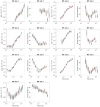Two-dimensional Bayesian inversion of magnetotelluric data using trans-dimensional Gaussian processes
- PMID: 33994835
- PMCID: PMC8102138
- DOI: 10.1093/gji/ggab110
Two-dimensional Bayesian inversion of magnetotelluric data using trans-dimensional Gaussian processes
Abstract
Bayesian inversion of electromagnetic data produces crucial uncertainty information on inferred subsurface resistivity. Due to their high computational cost, however, Bayesian inverse methods have largely been restricted to computationally expedient 1-D resistivity models. In this study, we successfully demonstrate, for the first time, a fully 2-D, trans-dimensional Bayesian inversion of magnetotelluric (MT) data. We render this problem tractable from a computational standpoint by using a stochastic interpolation algorithm known as a Gaussian process (GP) to achieve a parsimonious parametrization of the model vis-a-vis the dense parameter grids used in numerical forward modelling codes. The GP links a trans-dimensional, parallel tempered Markov chain Monte Carlo sampler, which explores the parsimonious model space, to MARE2DEM, an adaptive finite element forward solver. MARE2DEM computes the model response using a dense parameter mesh with resistivity assigned via the GP model. We demonstrate the new trans-dimensional GP sampler by inverting both synthetic and field MT data for 2-D models of electrical resistivity, with the field data example converging within 10 d on 148 cores, a non-negligible but tractable computational cost. For a field data inversion, our algorithm achieves a parameter reduction of over 32× compared to the fixed parameter grid used for the MARE2DEM regularized inversion. Resistivity probability distributions computed from the ensemble of models produced by the inversion yield credible intervals and interquartile plots that quantitatively show the non-linear 2-D uncertainty in model structure. This uncertainty could then be propagated to other physical properties that impact resistivity including bulk composition, porosity and pore-fluid content.
Keywords: Electrical properties; Inverse theory; Magnetotellurics; Non-linear electromagnetics; Probability distributions.
© The Author(s) 2021. Published by Oxford University Press on behalf of The Royal Astronomical Society.
Figures













References
-
- Agostinetti N.P., Malinverno A., 2010. Receiver function inversion by trans-dimensional Monte Carlo sampling, J. geophys. Int., 181(2), 858–872.
-
- Agostinetti N.P., Giacomuzzi G., Malinverno A., 2015. Local three-dimensional earthquake tomography by trans-dimensional Monte Carlo sampling, J. geophys. Int., 201(3), 1598–1617. 10.1093/gji/ggv084 - DOI
-
- Bezanson J., Edelman A., Karpinski S., Shah V.B., 2017. Julia: a fresh approach to numerical computing, SIAM Rev., 59(1), 65–98. 10.1137/141000671 - DOI
-
- Blatter D., 2020, Constraining fluid properties in the mantle and crust using Bayesian inversion of electromagnetic data, PhD thesis, Columbia University, New York City.
Grants and funding
LinkOut - more resources
Full Text Sources
Other Literature Sources
